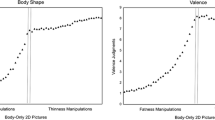Abstract
Results of the second year of a 3-year longitudinal study on children's body size estimations are reported. Participants were 216 male and female children age 6 through 13. Body size estimations were measured using a TV-video methodology. Three psychophysical procedures measured perceived body size, idealized size, and body dissatisfaction. Self-esteem, body esteem, birth order, number of siblings, and parents' socioeconomic status (SES) were measured.
Children were accurate in estimating body size, with no gender, age, or ethnic differences. Individual estimations varied greatly over the 1-year test-retest interval. Children had a slight bias to report that their body size was distorted too wide. Both genders wanted to be thinner, with females wanting to be increasingly thinner as they became older. Females were also more dissatisfied with their body size. Taller and heavier children with high SES fathers wanted a thinner idealized body size. Taller, thinner children had less body size dissatisfaction. Children with a larger number of siblings who were one of the first born were more dissatisfied with their body size. Children who gained weight during the previous year without a concomitant growth in height were also more dissatisfied with their body and wanted to be thinner. Body size estimation is viewed as an important aspect of one's body image and is mediated by many different variables, each of which individually explains only a small part of the variance.
Similar content being viewed by others
REFERENCES
Carter, F., Bulik, C., Lawson, R., Sullivan, P., and Wilson, J. (1996). Effect of mood and food cues on body image in women with bulimia and controls. Int. J. Eating Disord. 20(1): 65-76.
Cornsweet, T. N. (1962). The staircase method in psychophysics. Am. J. Psychol. 75: 485-568.
Fisher, S. (1986). Development and Structure of the Body Image. Vol. 2. Lawrence Erlbaum Associate, Hillsdale, NJ.
Freeman, R. J., Thomas, C. D., Solyom, L., and Hunter, M. (1984). A modified video camera for measuring body image distortion: Technical description and reliability. Psychol. Med. 14: 411-416.
Gardner, R. M. (1996). Methodological issues in assessment of the perceptual component of body image disturbance. Br. J. of Psychol. 87: 327-337.
Gardner, R. M., and Bokenkamp, E. D. (1996). The role of sensory and non-sensory factors in body estimations of eating disorder subjects. J. Clin. Psychol. 52: 3-15.
Gardner, R. M., and Moncrieff, C. (1988). Body image distortion in anorexics as a non-sensory phenomena: A signal detection approach. J. of Clini. Psychol. 44: 101-107.
Gardner, R. M., Martinez, R., and Sandoval, Y. (1987). Obesity and body image: An evaluation of sensory and non-sensory components. Psychol. Med. 17: 927-932.
Gardner, R. M., Espinoza, T., Urrutia, R., Morrell, J., and Gallegos, V. (1989a). Effect of hunger on body image in the obese: Feeling full, feeling fat. Psychiatric Forum. 15(2): 57-62.
Gardner, R. M., Morrell, J., Watson, D., and Sandoval, S. (1989b). Subjective equality and just noticeable differences in body size judgments of obese. Perceptual Motor Skills 69: 595-604.
Gardner, R. M., Gardner, E. A., and Morrell, J. A. (1990). Body image of sexually and physically abused children. J. Psychiatric Res. 24: 313-321.
Gardner, R. M., Jones, L. C., and Bokenkamp, E. D. (1995). Comparison of three psychophysical techniques for estimating body-size perception. Perceptual Motor Skills 80: 1379-1390.
Gardner, R. M., Sorter, R. G., and Friedman, B. N. (1997). Developmental changes in children's body image. J. Soc. Behav. Personal. 12: 1019-1036.
Garner, D. M., and Garfinkel, P. E. (1981). Body image in anorexia nervosa: Measurement, theory and clinical implications. Int. J. Psychiatric Med. 11: 263-284.
Harter, S. (1985). Manual for the Self-Perception Profile for Children. University of Denver, Denver, CO.
Hintze, J. L. (1996). Number Cruncher Statistical System, Version 6.0.21. NCSS, Kaysville, UT.
Jacobi, L., and Cash, T. F. (1994). In pursuit of the perfect appearance: Discrepancies among self-ideal percepts of multiple physical attributes. J. Appl. Soc. Phychol. 24: 379-396.
Mendelson, B. K., and White, D. R. (1982). Relation between body-esteem and self-esteem of obese and normal children. Perceptual Motor Skills 54: 899-905.
Myers, P. N. and Biocca, F. A. (1992). The elastic body image: The effect of television advertising and programming on body image distortions in young women. J. Commun. 42: 108-133.
Nakao, K. and Treas, J. (1994). Updating occupational prestige and socioeconomic scores: How the new measures measure up. In Marsden, P. V. (ed.), Sociological Methodology, 1994, Vol. 24. Blackwell Publishers, Ann Arbor: MI, pp. 57-80.
Petersen, A. C., Schulenberg, J. E., Abramowitz, R. H., Offer, D., and Jarcho, H. D. (1984). A self-image questionnaire for young adolescents (SIQYA): Reliability and validity studies. J. Youth Adolesc. 13: 93-111.
Pruzinsky, T. and Cash, T. F. (1990). Integrative themes in body-image development, Deviance, and Change. In Cash, T. C., and Pruzinsky, T. (eds.), Body Images: Development, Deviance, and Change. Guilford Press, New York, pp. 337-350.
Smeets, M. A. M. (1996). Body Size Estimation Research in Anorexia Nervosa: Breaking the Deadlock. Unpublished doctoral dissertation, University of Utrecht, Netherlands.
Smeets, M. A. M., Smit, F., Panhuysen, G. E. M., and Ingleby, J. D. (1997). The influence of methodological differences on outcome of body size estimation studies in anorexia nervosa. Br. J. Clin. Psychol. 36: 263-277.
Strauman, T. J., and Glenberg, A. M. (1994). Self-concept and body-image disturbance: Which self-beliefs predict body size overestimation. Cog. Therapy Res. 18: 105-125.
Tabachnick, B. G., and Fidell, L. S. (1996). Using Multivariate Statistics. Harper Collins, New York.
Watt, R. J., and Andrews, D. P. (1981). APE: Adaptive probit estimation of psychometric functions. Curr. Psychol. Rev. 1: 205-214.
Author information
Authors and Affiliations
Rights and permissions
About this article
Cite this article
Gardner, R.M., Friedman, B.N. & Jackson, N.A. Body Size Estimations, Body Dissatisfaction, and Ideal Size Preferences in Children Six Through Thirteen. Journal of Youth and Adolescence 28, 603–618 (1999). https://doi.org/10.1023/A:1021610811306
Issue Date:
DOI: https://doi.org/10.1023/A:1021610811306




